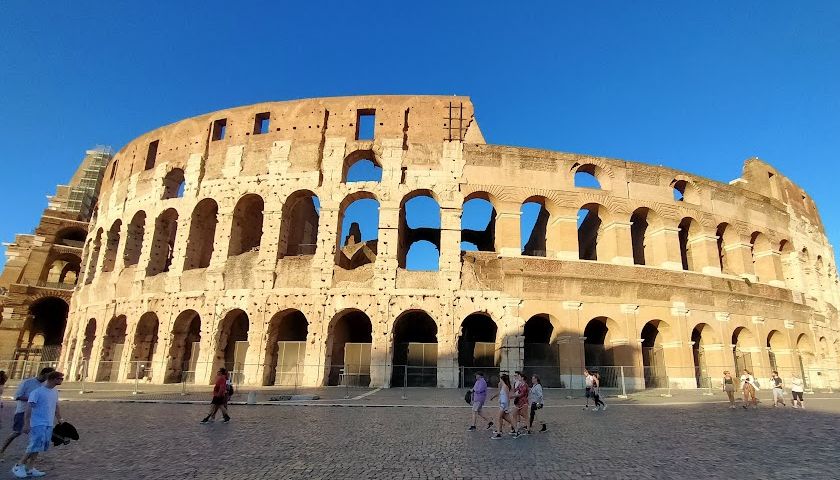Are you planning to spend one week in Rome and do not know where to start in a city so brimming with history and culture? You’re in the right place! As experts in Italy luxury travel, we’ve sourced the city’s top experiences by crafting this exhaustive 7 days itinerary in Rome to live an exciting and evocative journey.
Rome Monuments
Rome’s monuments are such an integral part of the urban fabric that at times it can be hard to tell where all the art for beauty’s sake ends and the actual city begins. Everywhere you turn you are likely to come face to face with masterpieces, embellishments and architectural details of every caliber that will send your curiosity reeling.
From its famous ancient wonders like the Colosseum, Roman Forum and Pantheon, to Renaissance palazzi and piazzas adorned with Baroque fountains and facades, walking the historic center of Rome is a journey of discovery that uncovers the most luminous moments of the city's past.
The list is nearly limitless, but after seeing its archaeological sites, no visit is complete without beholding the Spanish Steps and Trevi Fountain, as well as a stroll through Piazza Navona to see Bernini’s amazing Fountain of the Four Rivers. Other important squares include Piazza del Popolo and Campo de' Fiori, not to mention Rome's incredible churches.
Where to Go and What to Do if you have 7 Days in Rome
Discover Italy's open air museum. The below 7-day Rome itinerary is perfect if you’re interested in traveling to the Eternal City but aren’t sure where to begin. Tours that get you closer. Hotels that hit all your must-haves. Restaurants worth raving about. Discover Italy's Open Air Museum. Find all the best stuff for your Rome trip right here on this article. Always tried and tested by us.
With 7 days you can definitely experience the flavor of Rome, though I’m already predicting that you’re going to want to come back for a second visit! Rome is one of Italy's great cities and you could spend all 7 days here and barely scratch the surface.
Notes on Where to Stay: The historic center of Rome, where almost all of the relevant sights are is probably the most desirable area for first-time visitors. The major sites are within a 20-minute walk, at most, and strolling is a pastime unto itself in Rome. Hotels in this area, however, tend to fill up far in advance, so if you have 7 days in Rome, you are better off planning and booking your trip as soon as you are certain of when you’ll be visiting.
7 Days in Rome: The perfect one week itinerary
Day 1: Get Acquainted with Rome's Historic Center
Spanish Steps
Heart of the most elegant and exclusive area of the historical center, Piazza di Spagna has always been a meeting place for the Romans, but also for foreign visitors and artists who in the past used to stay in the numerous hotels and inns in the neighboring streets.
The famous staircase, designed in the 1700s by Francesco De Sanctis, proved to be an efficient and spectacular solution to the age-old problem of the connection between the square, controlled at length by the Spaniards whose embassy was located there, and the “French area” at the top of the hill that included the Renaissance church of the Trinità dei Monti. The 138 steps in the staircase are animated by terraces and curved sections that create the effect of a waterfall precipitating into the square below.
The Fountain of the Barcaccia was designed by Pietro Bernini, Gian Lorenzo’s father, and it represents a sinking boat placed in a low basin, a brilliant solution to the problem of low pressure in the conduits of the aqueduct that feeds it and that did not allow high jets of water. The streets around the square are famous for the boutiques of the most famous brands in international fashion and include Via Condotti, one of the most elegant streets in the world.
Trevi Fountain
The spectacular effect of the Trevi Fountain is not revealed gradually; none of the streets leading to it is in axis with the fountain itself. It is rather the sound of the water that suggests its proximity, but we reach it all of a sudden, and it is as if a curtain was lifted in front of our eyes in a surprise effect that never fails.
Designed in the 18th century by architect Nicola Salvi and built over thirty years, the Trevi Fountain is the celebration of water as a symbol of life, health and change. Its location indicates the end of the course of the ancient aqueduct of the Acqua Vergine (19 BC), the history of which is related on the reliefs in the upper section of the facade. The charm of the fountain is enhanced by the contrast between its large size and the small square that contains it and seems to almost compress it, along with its location on the side of a building that does not allow the viewer to walk around it as it normally occurs.
The personification of Ocean at the center of the structure appears to emerge from the water on a chariot led by sea horses and tritons, amidst rocks that are decorated with the representation of thirty varieties of plants. The overall effect is a unique combination of sculpture, architecture and nature in which we can imagine the building blending with the rocks and the gushing water.
Don’t forget to throw the famous coin to ensure your return to the Eternal City! To respect the “proper procedure” one must stand with one’s back to the fountain and throw the coin with the right hand over the left shoulder.
The Pantheon
One of the most impressive architectural masterpieces of all times, the Pantheon was built by the Emperor Hadrian in the 2nd century AC as a temple dedicated to the major gods of the pagan religion. In 608 AD, Pope Boniface IV transformed it into a church dedicated to Mary and all the martyrs and thus allowing to survive as the best preserved monument left over from antiquity.
Ground level was lower at the time of its construction and the portico was preceded by a few steps. It is wonderful to notice how through the centuries the city has grown around the Pantheon, incorporating it and maintaining it at the heart of its existence. From the outside, with its portico of monolithic granite columns, the Pantheon almost resembles the facade of a Greek temple, and yet the interior, with the rotunda and the immense concrete dome, is a perfect example of Roman architectural space.
The Emperor Hadrian was a great lover of Greek culture and identified Rome as Greece’s heir, and seems to create an intellectual progression here in which we reach Rome by passing through Greece. The interior is conceived as a sphere inserted in a cylinder; the diameter and the height of the dome, the largest ever built in concrete until the modern age, are identical and both measure 43,30m.
Suggestion: Fit in a counter cappuccino while you’re at it. Stop at famed Caffé Sant’Eustachio where espresso is brewed with water from an ancient aqueduct.
Piazza Navona
Piazza Navona is one of the most spectacular squares of Baroque Rome and a splendid example of how the ancient appearance of the city can often be traced and identified in the most popular places of its contemporary life. The elongated shape of the square repeats the structure of the Stadium of Domitian, built in the 1st century AC for sports competitions, and the remains of which are still visible beneath the present street level in Piazza di Tor Sanguigna.
The square acquired the aspect we enjoy today in the Baroque period, with the creation of Bernini’s Fountain of the Four Rivers, and the Church of Sant’Agnese in Agone that were designed in part by his “rival” Borromini. The giants on the Fountain at the center of the piazza, inaugurated in 1651, represent the four major rivers of the continents known at the time: the Rio de la Plata, the Danube, the Ganges and the Nile, famous for its covered face that indicated the mystery of its origins, as its source had yet to be discovered.
The representation of plants and animals, along with the movement and sound of the water, seem to bring life and animation to the fountain, which is surmounted by one of the thirteen obelisks in Rome, and is decorated with the coat of arms of the Pamphilj pope. The hollow section at the center of the structure is an ingenious idea, as it allows the viewer to see through the fountain without blocking the perception of the full extension of the square.
In the past Piazza Navona was a market place and a venue for festivals during which it used to be partially flooded for the carriage parades of local aristocratic families, and is still animated by the traditional Christmas fair, performers, street artists and many outdoor cafes. You’ll discover a great variety of restaurants in the streets surrounding this piazza to end your first night in Rome.
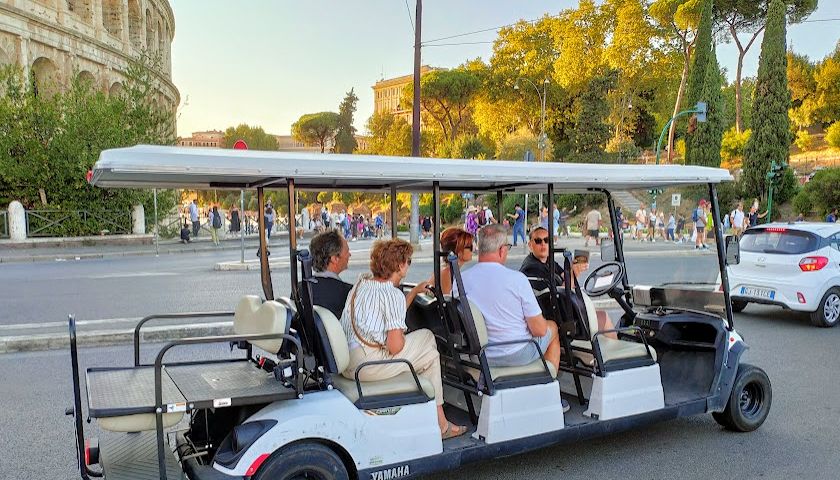
Pro Tip: Golf Cart in Rome is a fun, original and unforgettable way to explore the city center and its monuments in a comfy way.
Day 2: Ancient Rome
Colosseum
Architectural marvel of antiquity and symbol of the Eternal City throughout the world, the Flavian Amphitheatre is the largest structure for entertainment with gladiators and wild animals ever built by the Romans. Erected in 8 years (72-80 AD) by the Flavian dynasty on the place previously occupied by the artificial lake of Nero’s Golden House, using 100.000 square metres of travertine and 300 tons of iron, the Colosseum was inaugurated with 100 days of games.
The 60.000 spectators that it could hold entered through the 80 numbered arches at street level and, after spending the entire day there, could leave in under 20 minutes. The events offered hunts with wild animals in the morning, executions of condemned criminals at midday and gladiator combat in the afternoon and in warm weather the audience was protected from the sun by an awning consisting of 240 sails maneuvered by sailors of the imperial fleet.
The underground section at the center of the arena was used to keep the cages with the animals and the equipment for the games. The floor was placed above that and was made of wooden flanks covered with a layer of sand. Walking through the corridors of the Colosseum today we cannot help but notice its ambiguous and almost paradoxical attraction as, on one hand it seems to represent the best of the Roman civilization in the grandiosity of its architecture, and on the other it seems to express its darker side in the cruelty of the shows that were offered here.
In the Middle Ages the Colosseum was transformed into a fortress and later used as a quarry of building material. The iron clamps that held the blocks of travertine together were extracted and melted down for other purposes, leaving the holes that are visible throughout the structure.
Suggestion: in order to avoid the long lines and get a better understanding consider booking a private tour. The Glory of Rome seems much more glorious when narrated by knowledgeable and friendly guide who can resurrect the city from the scattered ruins with their informed descriptions.
The Roman Forum
The Roman Forum is the most important archaeological area in the city, the ideal place to understand that having a “historical sense” means, as the great writer T.S. Eliot says, feeling that the people of the past are our contemporaries. The Forum was the center of the public life of the ancient city where the political, religious and commercial activities of ancient Rome took place.
We must use our imagination to recreate it, as it must have been at the time, full of buildings and people from all over the empire who, just like us today, wanted to see the symbol of the incredible adventure that had led a community of shepherds to become owners of the world. The Romans charged their buildings with an important function of propagandist communication, aiming at producing in the viewer a sense of admiration mixed with fear.
We find basilicas for business meetings and for the administration of justice, the Curia, seat of the Senate, temples, triumphal arches, monuments and statues. The area was crossed by the Via Sacra which was used for triumphal parades. With the passing of time and the increase in the population, the area was extended with the addition of Imperial Forums that also contributed in stressing the greatness of the empire. Later, as decline set in, the Forum was abandoned and used as a source of building material.
Piazza del Campidoglio
Ancient seat of the most important temple of the state cult and symbol of Rome “caput mundi”, the Campidoglio has always maintained its importance in the life of the city as center of the City Government since the 12th century and with the presence of the Capitoline Museums, the most ancient in the world.
The square, considered one of the most elegant in Europe, was designed by Michelangelo who created the splendid access ramp, new facades for the preexisting buildings (Palazzo Senatorio at the centre and the Palazzo dei Conservatori on the right), and added the Palazzo Nuovo on the left, giving it the trapezoidal shape that never fails to communicate a sense of harmony and equilibrium to visitors.
The orientation of the square helps us understand the evolution of the city that at Michelangelo’s time had already turned its back to the remains of ancient Rome, the place of the past, of a historical phase that was concluded, to face the new center of power and rule of the day, the Vatican.
The original of the bronze statue of Marcus Aurelius, whose copy is placed at the center of the square is preserved in the Museum and escaped destruction in later times only because the personage on horseback was identified with Constantine, the first Christian emperor.
Day 3: The Vatican City, Castel Sant’Angelo and Trastevere.
MORNING
The Vatican City rises on the site where St. Peter was martyred and buried. The first Christian Emperor Constantine built a splendid basilica there in the 4th century AC which was in later times demolished and rebuilt over a period of almost 120 years (1506-1614). The greatest architects of the period, including Bramante, Michelangelo and Maderno, collaborated in the project of the new church, the largest in the world with its surface adding up to 22,000 square meters.
The Vatican Museums and their immense wealth of art, resulting from centuries of papal collections and commissions, offer an extraordinary experience in which the relevance of the works on display is heightened by the splendor of the structures in which they are displayed, and that are in themselves worth a visit. We do not proceed through buildings designed specifically to allow the large numbers of contemporary visitors to see artistic objects in a functional manner, but we walk through the galleries and rooms of papal palaces, at one time reserved for a small elite.
The Museums offer a great variety of collections, including ancient Greek as well as Roman art (of which the Vatican owns the largest collection in the world), Egyptian and Etruscan art and, of course, the great masterpieces of Renaissance art with the frescoes of the Raphael Rooms and the Sistine Chapel. This is a great opportunity to realize how coming to Rome often has more to do with remembering what we have always somehow known, than with discovering things for the first time.
Images that are strongly related to the identity of Western artistic culture are here. The restoration of the Sistine Chapel lasted 20 years and revealed the brilliance of the original colors, allowing us to fully enjoy the details of the biblical episodes on the ceiling and of the Last Judgement by Michelangelo, with its almost 400 figures captured in the most dramatic moment in the history of humanity. The Sistine Chapel also contains the famous 15th century frescoes by Botticelli, Perugino and Ghirlandaio, among others.
Suggestion: In order to avoid long lines, if possible, plan your visit after 2pm, when the Museums are less crowded. Consider booking a tour, which will allow you to bypass the long lines.
The Basilica of St. Peter’s offers one of the most impressive experiences of architectural space available anywhere. Photographs cannot convey the impact on the visitor of the vastness of the structure, of the splendid decorations and works of art it contains. The church is also famous for its almost total absence of paintings, substituted with mosaics by the Vatican School.
St. Peter’s Square can contain 300,000 people; it defines the border with Italy and welcomes visitors with the embrace of the colonnade designed by Bernini. It is the site of important ceremonies tied with the pope’s direct relationship with the people, such as audiences and blessings.
AFTERNOON
Via della Conciliazione leads to Castel Sant’Angelo, the fortress of the popes built in the Middle Ages above the remains of the tomb of the Emperor Hadrian (2nd century AD). Its structure is an example of the continuity between past and present in the urban fabric of Rome, where ancient buildings were often reused and adapted to serve new purposes, thus maintaining an active role in the history of the city.
The location of the emperor’s mausoleum on the right bank of the river Tiber, close to the Vatican, determined its use as a defensive rampart, connected to the papal palaces by a passageway, known as the “Passetto”, and endowed with a moat surrounding it, drawbridges and cannons. In the past, the castle was famous for its terrible dungeons, described by Benvenuto Cellini who made an adventurous escape from them. It was also a place of public executions, as recalled by the opera Tosca, which sees its tragic ending here.
Walking through the 58 rooms the Museum of the Castel Sant’Angelo today is a journey through its 1800 years of history and the many terraces offer extraordinary views of the city. Don’t miss the Bridge of the Angels, with the statues by the Bernini school that in the past announced to pilgrims on their way to visit the tomb of St. Peter, that the goal of their journey was near.
The area of Trastevere is ideal for a walk through narrow streets, squares and colors that still maintain an authentically Roman character and offers a pleasant contrast with the solemn splendor seen at the Vatican. In antiquity Trastevere – “beyond the Tiber” – was the first district established on the right bank of the Tiber and was inhabited by artisans, fishermen, merchants and communities of foreigners, connected with the activities of the nearby port.
Trastevere was also famous for its magnificent villas and vast gardens, the most important of which belonged to Julius Caesar who may have hosted Cleopatra there and left them in his will to the people of Rome. In the Middle Ages the neighborhood acquired the aspect it still preserves today in its narrow alleys and small squares that often defy any idea of a rational overall urban design, and give the impression of having adapted to preexisting structures.
Sites that should not be missed include the ancient Basilica of Santa Maria in Trastevere and of Santa Cecilia. To find the magnificence of the Renaissance even in Trastevere, the ideal place is the Farnesina, the suburban villa of wealthy banker Agostino Chigi, containing frescoes by Raphael, Baldassarre Peruzzi and Sebastiano del Piombo. Trastevere offers a great variety of restaurants and bars for a fun evening. If you are looking for the tastes of the traditional Roman cuisine, you can stop by at the Da Enzo al 29, very popular restaurant in Rome where you can also taste excellent wines.
Day 4: Become a Roman Chef For a Day
Discover the Roman food culture while expanding your culinary repertoire and skills. If you’re looking for an original and fun activity to do with yours consider taking a private cooking class. Under the guidance of a knowledgeable and friendly Italian chef, you will learn how to prepare a typical Roman meal. Of course, you will be able to taste your work at the end of the course!
Day 5: Out of Town Excursion to Ostia Antica, a Walk in EUR or a Visit to the Centrale Montemartini
MORNING
Ostia Antica
The archaeological site of Ostia Antica offers a unique opportunity to complete the image of the ancient city by exploring the aspect of daily life, otherwise difficult to identify among the great public monuments of capital. Founded around the 4th century BC as a military base between the mouth of the Tiber and the coast, Ostia soon became the commercial port of ancient Rome and for this reason was tightly connected to its history.
The goods destined to the support of the capital, but also to its urban development and entertainment industry, came through here. Grain, oil, wine, precious marble, animals for the circus, arrived here from all over the Mediterranean, and were often transferred onto smaller boats that went up the river hauled by oxen on the river banks, up to the port in Rome. It is easy to imagine Ostia as a thriving town of 60,000 people as we walk through the rather well preserved remains of the forum, the baths, temples, and residential neighborhoods that must have housed many foreigners as well.
Among the sites that deserve to be seen, are the ancient theater, still in use today, and the Square of the Guilds, a structure consisting of 60 representative offices of the different associations of artisans and merchants who worked here. The existence of Ostia was not interrupted suddenly as occurred in Pompeii; its decline coincided with that of Rome but was made worse by the gradual silting up of the port and by floods that changed the course of the Tiber, favoring the spreading of malaria. Ostia was never inhabited again in a significant manner after that, and this allows us to follow the various phases in the evolution of an ancient city without the adding of structures from later times.
The visit is made especially pleasant by the extraordinary natural context, a fundamental element in the perception of the romantic charm of ruins that was highly appreciated by 19th century travelers. Even here, Nature seems to almost regain possession of the space taken up by the work of man, creating a landscape that communicates a strong sense of the ineluctable passing of time.
AFTERNOON
EUR
On the way back from Ostia Antica go for a walk through EUR and explore the more modern aspect of the city. The area was originally intended to host the “Esposizione Universale di Roma” scheduled for 1942, in the context, at the time, of a debate on contemporary architecture and town planning. The Exhibition never took place owing to the start of World War II and EUR was completed after the end of it. Conceived as part of a plan for the southward development of the city, the neighborhood was built ex novo according to criteria drawn for ancient Roman architecture and urban planning in its monumental and rational aspects that can also be found in Renaissance classicism.
Structures of special interest include the Palazzo dei Congressi, the Museum of Roman Civilization and the Palazzo della Civiltà Italiana, known as the “square Colosseum” and that, in its abstract interpretation of classical architecture, greatly contributes to the surreal and metaphysical atmosphere of EUR also evident in the wide avenues and well separated buildings.
The Centrale Montemartini represents one of the most original and remarkable outcomes of the coexistence of ancient and modern in Rome. Ancient statues from the collections of the Capitoline Museums are displayed in the rooms of the first public electrical power plant of the city, inaugurated in 1912, and the only one that kept working during the Second World War thanks to the ingenious stratagem of hoisting the Vatican City flag above it.
More than 400 statues of gods, heroes and personalities of imperial rank populate the machine rooms amidst transformers and generators that evoke the sound of turbines, creating a highly evocative surreal effect. Walking through the perfectly restored rooms (a successful example of industrial archaeological recovery), we perceive the dynamic relationship between the luminous, timeless marble of the statues and the modern energy suggested by the machines, that seem to contend for the attention of the viewer. Do not miss the celebrated Togato Barberini, the basanite statue of Agrippina, the Victory of the Simmaci, and the statues from the Temple of Apollo Sosianus.
Day 6: Galleria Borghese
Located amidst the greenery of the favorite public park of the Romans, the Borghese Gallery is an authentic artistic treasure chest, the result of the passion for art of Cardinal Scipione Borghese, who in the early 1600s had the villa built with the specific purpose of housing his art collection. In order to enjoy it fully, it is important to enter the villa with a perception of the surrounding park and open air in a wonderful blend of art and nature that we now recognize as typical of Rome.
Once again, as at the Vatican Museums, we find the correspondence between the “container” and what it “contains”, in which the artistic value of the individual works is enhanced by the decorative splendor of the rooms in which they are displayed. It is important to bear in mind that the Borghese Gallery originated as a private collection and that the works and their display are not the result of didactic criteria (period, subject), but rather reflect the taste and intentions of its former owners.
Do not miss the series of sculptures made for the cardinal by young Gian Lorenzo Bernini (Eneas, the Rape of Proserpine, Apollo and Daphne, and David), that seem to invite us to participate in what is happening to them, Titian’s Sacred and Profane Love, Caravaggio’s masterpieces and the lovely Princess Paolina Borghese, Napoleon’s favorite sister, portrayed by Canova as Venus.
The Borghese Cardinal was famous above all for his capacity to discover new talents and for his methods in acquiring the works of art he wished to own, which on some occasions were not exactly lawful. He did not hesitate to have the Deposition by Raphael stolen from a church in Perugia and he had painter Domenichino imprisoned because he did not want to give him a painting commissioned to him by another cardinal.
Day 7: Christian Rome
The Catacombs
A visit to the Catacombs on the Appian Way allows us to trace the origins of the Christian presence in Rome and to explore one of the fundamental aspects of its identity. The Catacombs are in fact the underground cemeteries of the early Christians, located outside the city walls in accordance with the ancient custom that forbade the burying of the dead in the inhabited area.
They consist of a series of levels with passageways dug out of the tufa. The dead used to be wrapped in a shroud and placed in loculi and crypts carved out of the walls of the passageways themselves, and sealed with marble slabs or terracotta slabs, according to financial possibilities.
A persistent tradition identified the Catacombs as the hiding places of the early Christians at the times of the persecutions, but they were actually used exclusively as cemeteries and for devotional practices connected to the presence of the tombs of the saints and martyrs.
The frescoes and inscriptions on the funerary slabs indicate how death was conceived as a moment of rest before the final awakening to eternal life, and the catacombs were thus places of transition, in contrast to pagan necropolis, considered to be the permanent abode of the dead.
The Appian Way
A walk along the original slab stones of the ancient Appian Way is an ideal conclusion to a stay in Rome and a last occasion to evoke historical memories in a natural context of incredible beauty. The most ancient (4th century BC) consular road is an outstanding example of the practical genius of the Romans who conceived their road system as a way of taking possession of the world and dominating it. The great straight stretches allowed to move troops rapidly and efficiently and favored commerce. In building them the Romans were not conditioned by the layout of the territory but actually modified it by reclaiming marshy areas, building bridges and cutting hills. The Regina Viarum (Queen of Roads) built by censor Appius Claudius the Blind, after whom it was named, headed south and over time was extended to reach Brindisi, the gate to the East.
Walking along the ancient road, made up of layers of different materials, it becomes clear that the carriage way was wide enough to allow traffic in opposite directions, and that the wide sidewalks flanking it were intended for travelers on foot. The peace and quiet of today, with the long rows of pines and cypresses alternating with remains of funerary monuments, and the view of the Colli Albani, seems to make the traffic of people and carts that once animated this road, and indicated by the marks in the basalt slabs, even more remote. And yet, perhaps in the course of these Roman days the distance between the past and our times has become shorter and we can leave taking some of it home with us.
A suggestion for a special evening: end your last night in Rome at La Pergola if you’re up for a splurge. This three-Michelin-starred restaurant does not disappoint, and the candlelit terrace and city view is almost worth the price tag alone.
Plan Your Trip
Rome is an open air museum and you could easily spend months here and never come close to seeing everything. Get more out of Rome with a curated itinerary! From its hidden secrets to top sights, Nancy Aiello Tours creates custom itineraries to explore the facet of the Eternal City's open spaces.
 Rome & Vatican
Rome & Vatican Venice
Venice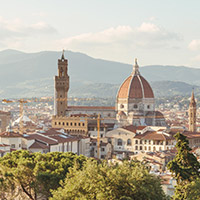 Florence & Tuscany
Florence & Tuscany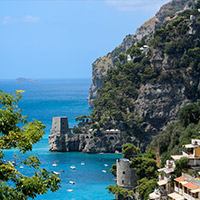 Napoli & Amalfi Coast
Napoli & Amalfi Coast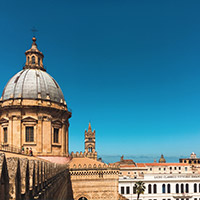 Sicily
Sicily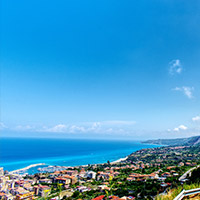 Calabria
Calabria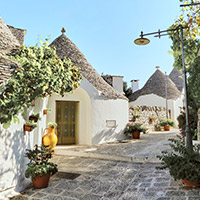 Matera & Puglia
Matera & Puglia